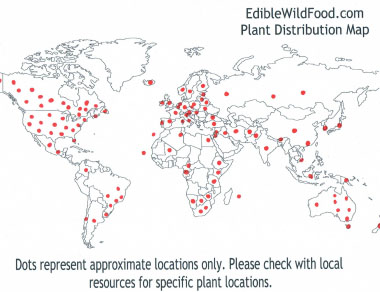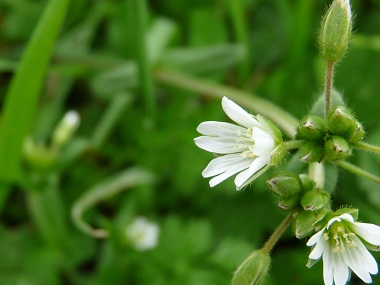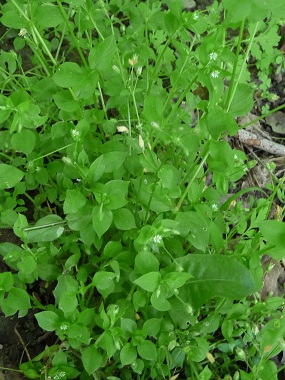







For comprehensive information (e.g. nutrition, health benefits, recipes, history, harvesting tips, etc.) please check out our Chickweed PDF magazine.
There are two chickweeds (Stellaria media and Cerastium fontanum) that are virtually indistinguishable unless closely examined. Both are mat-forming, in the Caryophyllaceae family, and occur in many countries. While the flowers are similar, mouse-ear chickweed (Cerastium fontanum) is easily distinguished by its fuzzy leaves and stems, whereas common chickweed (the variety discussed below) has hairless leaves and a single row of hairs along the stems. This edible plant is multi-functional since its presence decreases insect damage to other plants. It is a short-lived perennial that grows from taproots and often from sprawling, nodally-rooting branches.
Distinguishing Features
Chickweed grows in a unique, intertwined manner, and it has small white flowers that have a slight split at the tip of each petal. It typically blooms in early to mid spring.
Flowers
Chickweed flowers are small, white, and are held tightly in the upper leaf axils. They open into loose branching clusters with age on 1/2 inch hairy stalks. Each flower is about 1 cm across with 5 deeply notched white petals, usually with ten stamens with light yellow to greenish or even reddish anthers and a round green ovary in the centre with 5 filament-like styles at the top. The five sepals are about as long as the petals, lance shaped with fine, spreading hairs on the outer surface. Flower stalks are also slightly hairy; at flowering time they are erect to ascending and longer than the sepals, spreading more when fruiting.
 Fields
of Nutrition has medicinal benefits and vitamin/mineral content of Chickweed.
Fields
of Nutrition has medicinal benefits and vitamin/mineral content of Chickweed.
Leaves
Chickweed leaves occur opposite, are toothless, stalkless, and somewhat variable in shape. Lower leaves are spatula to egg-shaped, .8 to 2.5 cm long and .6 to 1.2 cm wide, the upper leaves becoming more lance-elliptic to oblong.
Height
This tasty wild edible grows from 5 cm to 50 cm tall. The stems may be erect but typically sprawl along the ground, rooting at the nodes, with short sterile branches crowded around the base, the longer flowering branches barely ascending towards the tip. Stems may be erect but typically sprawl along the ground, rooting at the nodes, with short sterile branches crowded around the base. Stems are covered with fine, spreading, non-glandular hairs.
Habitat
Chickweed grows in many areas in a wide variety of habitats and soil textures. It is one of the most common weeds founds in lawns but it also grows well in cultivated fields, pastures, waste areas and in some deciduous forests. This plant occurs in many countries.
Edible Parts
Leaves are used by adding them raw to salads and sandwiches. They can be tossed into soups and stews as well. When adding to a cooked dish, the stems and flowers can be used also.
Other Name
Common Chickweed.
Similar Plants
Recipes
Buttered Chickweed, Chickweed Salad, Deviled Eggs a la Chickweed Hummus, Nourishing Skin Salve
To support our efforts please browse our store (books with health benefits, etc.).
Winter Survival Food Handbook

PDF Plant Magazines
Types of Wild Food
Geographic Zones Seasons
Disclaimer
EdibleWildFood.com is informational in nature. While we strive to be 100% accurate, it is solely up to the reader to ensure proper plant identification. Some wild plants are poisonous or can have serious adverse health effects.
We are not health professionals, medical doctors, nor are we nutritionists. It is up to the reader to verify nutritional information and health benefits with qualified professionals for all edible plants listed in this web site. Please click here for more information.
Why Edible Wild Food?
- Food costs are rising
- Free, wild food is readily abundant
- Wild food adds nutrition to your diet
- Wild food can help treat various medical conditions





